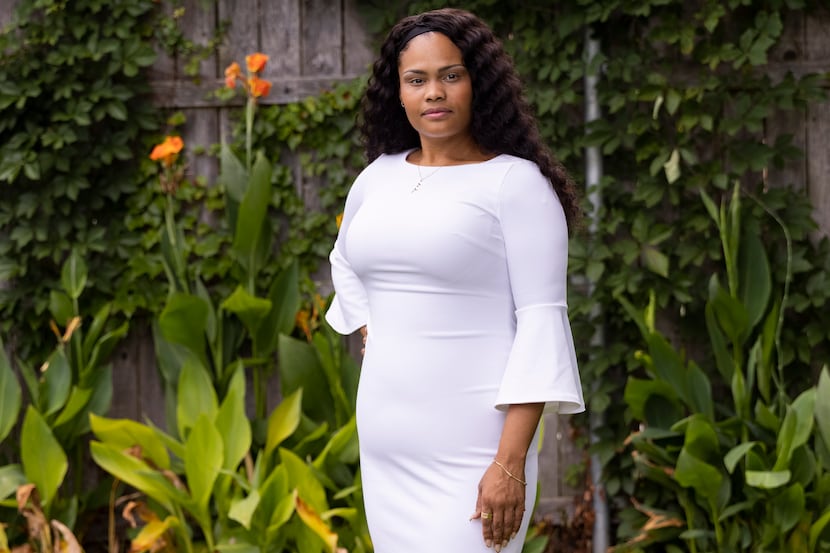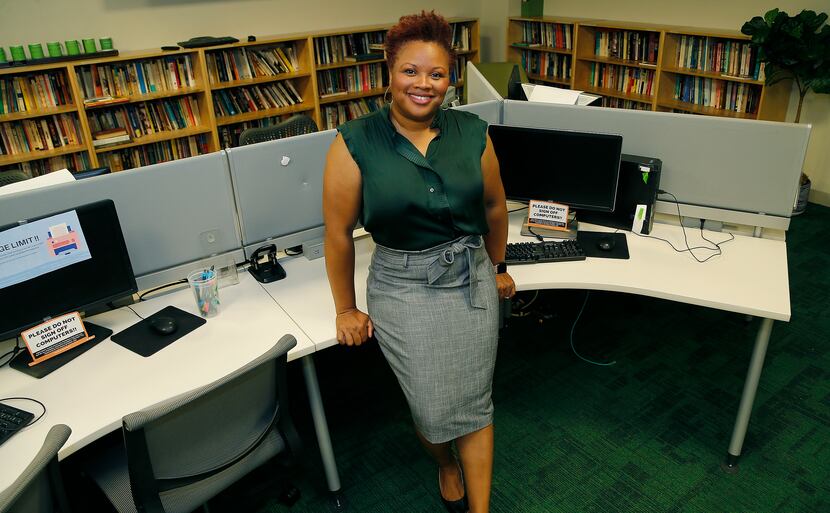Maxine Davis had enough of what she described as racial microaggressions and being routinely undermined at work, so she decided this spring semester was her last teaching in Texas. Her exit underscores why fewer than 5% of tenured professors in the state are Black.
Davis spoke out about the racism she said she and students of color faced at the University of Texas at Arlington, but colleagues often responded with hostility.
Once, she opened her campus mailbox to find an anonymous letter reproaching her professionalism and how she used slang words, such as “yo,” with other faculty. Shocked, Davis noted to school officials later that the word wasn’t one she used at all, rather one used in “caricatured versions of how I and Black people speak.”
Her experiences echo the often difficult work environments Black professors at Texas colleges have faced over the years. Davis was so stressed at UTA that she was hospitalized once for severe depression and then again for stroke-like symptoms. At one point, she said, she even attempted suicide.
Next semester, Davis will be teaching at the School of Social Work at Rutgers University in New Jersey.
“I didn’t want Black and brown students to see my face on the [UTA] website and think that it was the best place for them,” she said.
Tenure guarantees professors academic freedom and job security, making the sought-after designation well worth what is usually a six-year process. Davis lasted only a third of that.
Last summer’s protests and racial reckoning led many universities to reaffirm a commitment to diversity, but that commitment has been slow to materialize. In the last 10 years, Texas universities made few strides to increase the number of Black tenured faculty, according to an analysis by The Dallas Morning News.
In 2011, 4.13% of all tenured professors in Texas were Black. By 2019, 4.64% were Black.
Almost no four-year public or private higher education institution in Texas has more than 9% Black tenured professors, according to the most recently available federal data. Historically Black colleges and universities, or HBCUs, in Texas with tenure all have a rate of at least 40%.
“Higher education is not immune to structural racism,” said Irene Mulvey, the president of American Association of University Professors.
She pointed to the University of North Carolina at Chapel Hill’s recent decision to not grant tenure to Nikole Hannah-Jones, who won a Pulitzer Prize for creating the 1619 Project. It appeared “inappropriate, racist and blatantly political,” Mulvey said. University officials eventually granted Hannah-Jones tenure on June 30 after backlash from faculty, students and the public.
The dispute over Hannah-Jones’ tenure highlights challenges that many Black faculty, especially Black women, face in their path to tenure. Hannah-Jones ultimately declined the offer from UNC to accept a tenured position at Howard University, one the nation’s oldest HBCUs.
“The burden of working for racial justice is laid on the very people bearing the brunt of the injustice, and not the powerful people who maintain it,” Hannah-Jones wrote in her statement announcing the decision. “I say to you: I refuse.”
Paying the ‘Black tax’
Davis loves working with students, but she feels a particular responsibility to respond to Black students, who frequently reach out to her outside of class because they have no one else to turn to.
She often serves as a mentor when students feel like they don’t have “institutional support” to navigate academia or when they run into hurdles within their department programs.

Providing guidance for students from similar backgrounds is the kind of additional workload that Black faculty frequently take on, unlike other educators, said Yasmiyn Irizarry, a tenure-track professor at the University of Texas at Austin.
“Some faculty will call it a ‘Black tax,’” she said.
The “tax” emerges in various ways, such as when the university seeks out faculty of color for diversity, equity and inclusion work. They step up to serve on search committees or facilitate conversations about race.
Universities typically do not consider these services during the tenure review process, Irizarry said. The extra work is usually voluntary, but Black faculty often feel obligated to help so they don’t “risk relationships or risk support.”
Such emotional labor is on top of Black faculty often facing microaggressions, such as colleagues touching their hair without their consent; the lack of support from school administrators; and unwelcoming environments that make it even more difficult to succeed in university systems, Irizarry said.
“You deal with this kind of greater stress of navigating being Black and teaching and having people be much more likely to question your expertise,” she said.
That “greater stress” means universities will continue to lose faculty of color — even those who are tenured — because there is little institutional support, said Chandra Carey, head of the Black Faculty Network at the University of North Texas.
Hiring a person of color into a predominantly white department can leave them feeling isolated in a potentially hostile environment if proper support isn’t in place, she said.
Black faculty often have little say over which classes they can teach, don’t have their research taken as seriously or encounter colleagues or students who think they are less competent, she said.
“For some of the more recent losses [at UNT], it’s been the climate — what they have to face day to day in the department,” Carey said.
Like many schools across the country, UNT recently launched an anti-bias and cultural awareness program aimed at improving workplace climate.
“It is on all of us at UNT to be conscious of the environment we are creating ... at times we fall short of that goal,” wrote Jennifer Cowley, UNT’s provost, in a statement.
Turnover among faculty of color, in turn, can then perpetuate the pipeline challenge — the idea that there aren’t enough qualified candidates of color or women in doctoral programs that universities recruit from, she said.

The responsibility is not on individual students or faculty becoming more qualified as many are on track, Carey said. But universities need to do their part to make sure Black students and faculty stay because “environments aren’t conducive to students wanting to persist in those disciplines.”
Creating a ‘revolving door’
Creating a welcoming, supportive campus for Black faculty must be a priority for everyone — from the administration to individual faculty members, said Reginald DesRoches, Rice University’s provost.
But even when an administration says diversity is a top commitment, numbers can remain low. In 2019, 11 of Rice’s 425 tenured professors were Black — only 2.6%. In 2011, 1.8% of the Houston school’s tenured faculty were Black.
Part of the challenge is that hiring faculty is not a top-down decision but rather “is very much localized” to individual departments and schools within a university, DesRoches said.
To improve their numbers and create an inclusive process, his office works closely with department chairs and search committees to make sure they cast a “really wide net.”
Rice’s dean and provost have asked search committees to try again if they felt a pool of candidates wasn’t diverse enough.
Uneven diversity across departments is also the case at UT. In 2020, 7.6% of tenured and tenure-track faculty in the College of Liberal Arts were Black, while only 1.1% of those in the College of Natural Sciences were, according to UT data.
“That has a lot to do with the various histories of race and who gets recruited for graduate programs,” said Edmund Gordon, UT’s vice provost of diversity. “But even more than that, I don’t think we can use the limitations of the [candidate] pools as the reason” for low numbers.
At UTA, officials have “identified the need to develop a university-wide talent management plan” for underrepresented faculty and staff, said Joe Carpenter, a spokesman. He added the plan is still in progress.
Carpenter did not comment on Davis’ allegations specifically but said the university responds “seriously and appropriately to concerns and allegations raised by faculty, staff and students.”
Even as the Arlington campus has increased its tenure numbers, Black professors have not benefited from that windfall.
From 2011 to 2019, UTA tenured 85 more professors. Only five of those newly tenured were Black, raising the total number of Black tenured professors to 14. In 2019, 3.1% of the Arlington school’s tenured professors were Black.
Many Black faculty say that universities need to set a standard and hold departments accountable to it.
In 2015, and again in 2020, the student-led #BlackAtSMU movement demanded that at least 10% of faculty at Southern Methodist University be Black. The faculty-led Black Unity Forum went a step further, specifying that those professors be tenured or tenure track.
From 2011 to 2019, SMU tenured two more Black professors, increasing its proportion of Black tenured faculty from 3.2% to 3.5%. (SMU supports the Education Lab at The Dallas Morning News.)
Improvement can be slow in part because tenure is granted in seven-year cycles, so changes made in 2015 will not necessarily manifest until 2022, said Maria Dixon Hall, who has served as SMU’s chief diversity officer since the position was created last summer.
In the meantime, the university is working to improve the experience for faculty of color. For example, SMU is developing policies that “increase compensation of faculty members working on inclusion-focused initiatives,” a step toward factoring in the “Black tax” when reviewing tenure, instead of considering just research and publications.
“If you don’t have processes that allow you to be equitable, then you cannot diversify,” Hall said. “Here’s what happens: You go out, you grab all these new people and they come into a system that doesn’t allow for inclusion and equity. All you’ve done is create a revolving door.”
That revolving door, in turn, makes retaining faculty of color even more difficult.
Producing different environments
Some Texas universities are launching recruitment and retention strategies aimed at long-term change.
UNT, for example, is among schools that have prioritized diversity in targeted hires, allowing for a qualified candidate to be considered for a faculty appointment without a national search.
Cluster hires — where departments hire multiple educators at once — have been used at the University of Texas at San Antonio. Such hires can mitigate some hostility or isolation felt by new faculty, especially in underrepresentative departments, according to the National Institutes of Health.
Some schools are trying to make diversity a priority by baking it into their uniform search processes. The University of Houston received a $3.3 million grant from the National Science Foundation in 2014 to boost its efforts to do so.
UH administrators created a search committee toolkit that helps department heads be “proactive” in diversity recruitment. For example, it advises posting job ads on standard job boards, as well as to scholarly organizations specifically for women and people of color.
And to ensure the retention of newly recruited faculty, UH’s provost’s office has provided $125,000 total over five years to the Underrepresented Women of Color Coalition, an affinity group on campus meant to provide mentorship and support to women faculty of color.
Meanwhile, many advocates also encourage universities to recruit more from historically Black colleges and universities, as well as from Hispanic-serving institutions, rather than focusing solely on prestigious universities, such as state flagships and Ivy League schools.
“These institutions are playing and serving a very important role to get African Americans into areas where they have been underrepresented for years and years and years,” said Fred Bonner, the American Association of Blacks in Higher Education’s director of research.
Diverse faculty members work as the guides and role models to encourage diverse students to join the workforce, Bonner said.
These, however, are just a few of the first steps that can be taken.
“Faculty of color that you’re trying to recruit have to see, over time, that these things are in place,” said Michael McFrazier, the dean of the college of education at Prairie View A&M, an HBCU.
Black faculty and other educators of color are seeking equal treatment, not special treatment, he said. “Those who are in leadership have to think about what they appreciate about a welcoming work environment and make sure that those things are in place for faculty of color.”
Institutions can’t use surface-level responses to solve deeply ingrained problems with “unwelcoming” campuses, said Michael Sorrell, president of Paul Quinn College.
Schools simply need to call out and stop tolerating racist behavior, said Sorrell, who leads the HBCU in southern Dallas. School leaders need to change campus culture so that people’s experiences aren’t defined by their race, he added.
“You need someone who’s willing to stand up and say, ‘Not on my watch,’” Sorrell said. “If we want something different, then we have to do the things that produce ‘different’ — it’s not that hard.”
The DMN Education Lab deepens the coverage and conversation about urgent education issues critical to the future of North Texas.
The DMN Education Lab is a community-funded journalism initiative, with support from The Beck Group, Bobby and Lottye Lyle, Communities Foundation of Texas, The Dallas Foundation, Dallas Regional Chamber, Deedie Rose, The Meadows Foundation, Solutions Journalism Network, Southern Methodist University and Todd A. Williams Family Foundation. The Dallas Morning News retains full editorial control of the Education Lab’s journalism.


